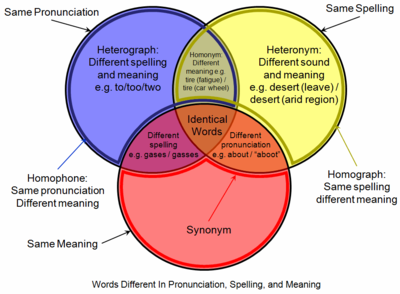Homograph
The examples and perspective in this articledeal primarily with the English language and the Chinese language and do not represent aworldwide viewof the subject.(September 2018) |

Ahomograph(from theGreek:ὁμός,homós'same' and γράφω,gráphō'write') is awordthat shares the same written form as another word but has a different meaning.[1]However, some dictionaries insist that the words must also be pronounced differently,[2]while theOxford English Dictionarysays that the words should also be of "different origin".[3]In this vein,The Oxford Guide to Practical Lexicographylists various types of homographs, including those in which the words are discriminated by being in a differentword class,such ashit,the verbto strike,andhit,the nouna strike.[4]
If, when spoken, the meanings may be distinguished by different pronunciations, the words are alsoheteronyms.Words with the same writingandpronunciation (i.e. are both homographs andhomophones) are consideredhomonyms.However, in a broader sense the term "homonym" may be applied to words with the same writingorpronunciation. Homograph disambiguation is critically important inspeech synthesis,natural language processingand other fields. Identically written different senses of what is judged to be fundamentally thesameword are calledpolysemes;for example,wood(substance) andwood(area covered with trees).
In English
[edit]Examples:
- sow(verb)/soʊ/– to plant seed
- sow(noun)/saʊ/– female pig
where the words areheteronyms,spelt identically but pronounced differently. Here confusion is not possible in spoken language but could occur in written language.
- bear(verb) – to support or carry
- bear(noun) – the animal
where the words arehomonyms,identical in spelling and pronunciation (/bɛər/), but different in meaning and grammatical function.
More examples
[edit]| Word | Example of first meaning | Example of second meaning |
|---|---|---|
| lead | Gold is denser thanlead/lɛd/. | The mother duck willlead/liːd/her ducklings around. |
| close | "Will you pleaseclose/kloʊz/that door! " | The tiger was now soclose/kloʊs/that I could smell it... |
| wind | Thewind/wɪnd/howled through the woodlands. | Wind/waɪnd/your watch. |
| minute | I will be there in aminute/ˈmɪnɪt/. | That is a veryminute/maɪˈnuːt///maɪˈnjuːt/amount. |
In Chinese
[edit]Many Chinesevarietieshave homographs, calledChữ đa âm(pinyin:duōyīnzì) orTrọng hình tự(pinyin:chóngxíngzì),Phá âm tự(pinyin:pòyīnzì).
Old Chinese
[edit]Modern study ofOld Chinesehas found patterns that suggest a system ofaffixes.[5]One pattern is the addition of theprefix/*ɦ/,which turnstransitive verbsintointransitiveorpassivesin some cases:[6]
| Word | Pronunciationa | Meaninga | Pronunciationb | Meaningb |
|---|---|---|---|---|
| Thấy[7] | *kens | see | *ɦkens | appear |
| Bại[8] | *prats | defeat | *ɦprats | be defeated |
| All data from Baxter, 1992.[6] | ||||
Another pattern is the use of a/*s/suffix,which seems to create nouns from verbs or verbs fromnouns:[6]
| Word | Pronunciationa | Meaninga | Pronunciationb | Meaningb |
|---|---|---|---|---|
| Truyền | *dron | transmit | *drons | (n.) record |
| Ma | *maj | grind | *majs | grindstone |
| Tắc | *sɨk | (v.) block | *sɨks | border, frontier |
| Y | *ʔjɨj | clothing | *ʔjɨjs | wear, clothe |
| Vương | *wjaŋ | king | *wjaŋs | be king |
| All data from Baxter, 1992.[6] | ||||
Middle Chinese
[edit]Many homographs in Old Chinese also exist inMiddle Chinese.Examples of homographs in Middle Chinese are:
| Word | Pronunciationa | Meaninga | Pronunciationb | Meaningb |
|---|---|---|---|---|
| Dễ | /jĭe꜄/ | easy | /jĭɛk꜆/ | (v.) change |
| Đừng | /bĭɛt꜆/ | (v.) part | /pĭɛt꜆/ | differentiate, other |
| Thượng | /꜂ʑĭaŋ/ | rise, give | /ʑĭaŋ꜄/ | above, top, emperor |
| Trường | /꜀dʲʱĭaŋ/ | long | /꜂tʲĭaŋ/ | lengthen, elder |
| Reconstructed phonology fromWang Lion the tables in the articleMiddle Chinese.Tone namesin terms oflevel(꜀ bình ),rising(꜂ thượng ),departing( đi ꜄), andentering( nhập ꜆) are given. All meanings and their respective pronunciations from Wang et al., 2000.[9] | ||||
Modern Chinese
[edit]Many homographs in Old Chinese and Middle Chinese also exist in modernChinesevarieties. Homographs which did not exist in Old Chinese or Middle Chinese often come into existence due to differences betweenliterary and colloquial readings of Chinese characters.Other homographs may have been created due to merging two different characters into the same glyph during script reform (SeeSimplified Chinese charactersandShinjitai).
Some examples of homographs inCantonesefrom Middle Chinese are:
| Word | Pronunciationa | Meaninga | Pronunciationb | Meaningb |
|---|---|---|---|---|
| Dễ | [jiː˨] | easy | [jɪk˨] | (v.) change |
| Thượng | [ɕœːŋ˩˧] | rise, give | [ɕœːŋ˨] | above, top, emperor |
| Trường | [tɕʰœːŋ˨˩] | long | [tɕœːŋ˧˥] | lengthen, elder |
See also
[edit]References
[edit]- ^ "One of two or more words that have the same spelling but differ in origin, meaning, and sometimes pronunciation, such as fair (pleasing in appearance) and fair (market) or wind (wĭnd) and wind (wīnd)".
- ^Homophones and Homographs: An American Dictionary, 4th ed.,McFarland, 2006, p. 3.
- ^Oxford English Dictionary:homograph.
- ^Atkins, BTS.; Rundell, M.,The Oxford Guide to Practical Lexicography,OUP Oxford, 2008, pp. 192 - 193.
- ^Norman, Jerry(1988).Chinese.Cambridge: Cambridge University Press. p. 84.ISBN978-0-521-22809-1.
- ^abcdBaxter, William H. (1992).A Handbook of Old Chinese Phonology (Trends in Linguistics. Studies and Monographs).Berlin and New York: de Gruyter Mouton. pp. 218–220.ISBN978-3-11-012324-1.
- ^The two meanings were later distinguished through the means of radicals, so that thấy ('to see', Std. Mand. jiàn) was unchanged, while thấy ('to appear', Std. Mand. xiàn) came to be written as hiện.
- ^This distinction was preserved in Middle Chinese using voiced and unvoiced initials. Thus, bại (transitive, 'to defeat') was read as bắc mại thiết (Baxter, paejH), while bại (intransitive, 'to collapse; be defeated') was read as mỏng mại thiết (Baxter, baejH). 《 tăng vận 》: Phàm vật không tự bại mà bại chi, tắc bắc mại thiết. Vật tự hủy hư, tắc mỏng mại thiết. Modern Wu dialects (e.g., Shanghainese, Suzhounese), which preserve the three-way Middle Chinese contrast between voiced/aspirated/unaspirated initials, do not appear to preserve this distinction.
- ^Wang Li; et al. (2000).Vương lực cổ Hán ngữ từ điển.Beijing: Trung Hoa thư cục.ISBN7-101-01219-1.
